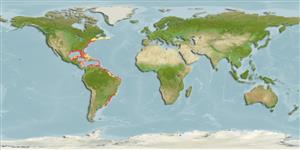Classification / Names
Common names from other countries
Main reference
Size / Weight / Age
Max length : 40.0 cm TL male/unsexed; (Ref. 7251); common length : 30.0 cm TL male/unsexed; (Ref. 5217); max. published weight: 500.00 g (Ref. 5217)
Length at first maturity
Lm 12.0 range ? - ? cm
Environment
Marine; reef-associated; depth range 30 - 200 m (Ref. 5951)
Climate / Range
Subtropical, preferred 27°C (Ref. 107945); 45°N - 37°S
Distribution
Short description
Dorsal
spines
(total): 8;
Dorsal
soft rays
(total): 32;
Anal
spines: 3;
Anal
soft rays: 28. Body elongate and slightly compressed; posterior edge of upper jaw reaching to below anterior margin of eye; eye large with a well developed adipose eyelid; shallow furrow on upper margin of shoulder girdle; body except for small part behind pectoral fin covered with small cycloid scales; body dark blue dorsally, silver-white ventrally; black blotch on posterior margin of opercle; tip of snout dusky; anterior margin and tip of first dorsal fin dusky, other parts pale; second dorsal fin pale; caudal fin dusky, pectoral and pelvic fins pale (Ref. 13608).
IUCN Red List Status (Ref. 115185)
Threat to humans
Harmless
Human uses
Fisheries: commercial
More information
ReferencesAquacultureAquaculture profileStrainsGeneticsAllele frequenciesHeritabilityDiseasesProcessingMass conversion
Tools
Special reports
Download XML
Internet sources
Estimates of some properties based on models
Phylogenetic diversity index
PD50 = 0.5001 many relatives (e.g. carps) 0.5 - 2.0 few relatives (e.g. lungfishes)
Trophic Level
4.0 ±0.2 se; Based on diet studies.
Resilience
Medium, minimum population doubling time 1.4 - 4.4 years (K=0.16; tm=2)
Vulnerability
Moderate vulnerability (37 of 100)
Price category
